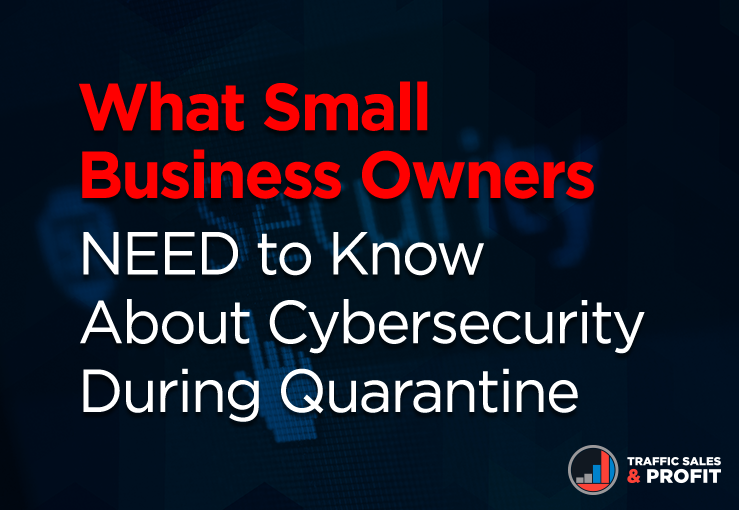With the majority of us strictly observing work from home mandates, internet traffic is larger than ever. That also means that more and more people are online, ready to capture and use your business’ data against you. 61% of data breaches directly affect small businesses specifically, and most small business owners don’t have the proper protocols in place to protect their assets. Unlike big corporations with entire cybersecurity departments, small business owners have to rely on consultants or their own savvy to protect their business online.
Check out these tips to get you up to speed and ensure your business is just as healthy as you are!
- Cybersecurity in a Nutshell
- How Your Assets Can Be At Risk
- Protect Your Business Online
- Cybersecurity Resources
- Final Thoughts
Cybersecurity in a Nutshell

So what really is “Cybersecurity”?
According to Cisco:
“Cybersecurity is the practice of protecting systems, networks, and programs from digital attacks. These cyberattacks are usually aimed at assessing, changing, or destroying sensitive information; extorting money from users; or interrupting normal business processes.”
In layman’s terms, Cybersecurity for small businesses is the action you take in order to protect vital business information while working in an online environment.
Since we’re living in the digital age, almost every business owner has some component of their operations online with more and more entrepreneurs leaving brick and mortar locations for online storefronts.
This makes not only being aware but staying on top of Cybersecurity best practices essential to the perpetuity of your business, its assets, and even your own personal data attached to it. Most of us aren’t thinking of taking extra steps or adding extra layers to our security online.
But, it’s important–now more than ever since more people are working from home–to make sure your Cybersecurity is up to date and ready to protect your business!
How Your Assets Can Be At Risk
There are many forms of malicious cyber attacks that can compromise your essential business assets. These attacks come in many forms and have many names but here’s a quick run down of the ones that small business owners may need to know:
- DDoS: Denial of service or DDoS attacks occur when a server is intentionally overloaded with requests until it shuts down the target’s website or network system.
- Inside attack: This is when someone within an organization purposely misuses his or her credentials to gain access to confidential company information.
- Malware: Any software with “malicious intent”, created to cause damage or gain unauthorized access to the downloader’s systems.
- Password attack: These are very common and the easiest way for hackers to access your information. There are 3 types: a brute-force attack, which involves guessing at passwords until the hacker gets in; a dictionary attack, which uses a program to try different combinations of dictionary words; and keylogging, which tracks a user’s keystrokes, including login IDs and passwords.
- Phishing: Perhaps the most commonly deployed form of cybertheft, phishing attacks involve collecting sensitive information like login credentials and credit card information through a legitimate-looking (but ultimately fraudulent) website, often sent to unsuspecting individuals in an email.
Though there are many more types of cyber attacks, these 5 are the most common and likely to affect small business owners that are utilizing the online landscape.
Not only can hackers and e-thieves get your financial information, they can find out where your office or home location is, your social security number, your mailing address, and much more from just a single one of these attacks.
And it’s unlikely that you’ll be getting just one. Since 2013, there are approximately 3,809,448 records stolen from breaches every day! Which calculates to 158,727 per hour, 2,645 per minute, and 44 every second of every day report according to Cybersecurity Ventures.
Protect Your Business Online

Protecting your business and personal data online seems like a monumental undertaking given the sheer volume of cyber attacks that occur every minute of every day.
But it is possible!
There are several ways you can ensure that your business is protected when you connect to the internet and ensure that your data is protected.
Create a Cybersecurity Policy
What’s the first step? A cybersecurity policy for your business!
According to Forbes, 43 % of cyber breaches claimed small businesses as victims, according to a 2019 Verizon Study.This number could have been reduced drastically if these companies had some form of cybersecurity policy and procedure in place.
But out of all the things you have to get to as a small business owner, cybersecurity isn’t usually at the top. In fact, it can get pretty complicated to figure out on your own.
No one is expecting for you to be an expert at it! You can hire a cybersecurity expert or consultant to help you establish a company-wide policy, advise on softwares or antivirus programs, and even perform mock cyber attacks to see how vulnerable your business is to a real hacker.
Review Admin Access of all Current and Former Employees
Make sure you set aside time to review administrative access to all of your company’s software and hardware before and after an employee leaves. Do this periodically, even if you’ve got employees that have been with your company for years.
Take special care to do this with contractors or freelancers that you give access to.
This is a simple and easy step you can take to ensure that your applications and software are being used for their intended purposes and you aren’t at risk for someone that no longer works for you–or even someone who does–to have access to data they aren’t supposed to.
Get a Good VPN for Remote Workers
A VPN, or Virtual Private Network, is a failsafe that you can employ to not only monitor employee activity if need be, but protect any assets they may be working with on their personal computers while working remotely.
Employees can be required to sign into your VPN before they start working and in order to get access to certain files which are protected by your service provider’s security protocols!
Even if you’re a solopreneur or don’t have standing employees, you can get your own personal VPN to protect yourself and your data while you work. These plans are affordable and geared towards keeping your personal information off of hackable directories while you’re browsing the web.
Change Your Passwords every 90 Days
This is the golden rule to cybersecurity! Changing your passwords regularly means it’s harder for a hacker to get a hold of them to steal your information online. Diversifying passwords–making sure none are exactly the same–also helps with this.
Requiring password rests for both your employees and yourself is another easy but essential step to a robust cybersecurity policy for your small business.
If you have trouble remembering your passwords after you change them, or just want a company-wide accessibility point for essential login information, you can check out LastPass, a free password keeper and management app with a robust set of built-in security measures.
Cybersecurity Resources
There’s no way you’ll be able to learn everything that goes into making a solid cybersecurity policy in one article; maybe not even in ten! There are always new best practices as hackers evolve to security measures and the digital landscape continues to expand.
However, we’ve compiled a list of handy resources that you can reference (along with this article) when you’re in need of some help!
- The FTC’s Cybersecurity Portal
- The FCC’s Cybersecurity Resource Page
- What Small Business Owners Need to Know About Cybersecurity
- Online Computer Scams
- Four Methods to Create a Secure Password You’ll Actually Remember
- Best VPNs for Small Businesses
- The Beginner’s Guide to Setting Up LastPass
Final Thoughts

Cybersecurity can be tough. Especially when you’ve got one hundred other tasks on your plate as a small business owner. However, it’s something you need to spend some time thinking about to ensure the safety of your organization.
More and more cyber attacks are happening by the day, so you’ve got to be up to date and aware of the best practices to protect your business and personal data.
Consider hiring a consultant to help you get a firm cybersecurity policy in place. Identify some apps or a VPN that will help you make sure both you and your employees are safe and accountable when using the internet. Change your passwords regularly to avoid being the target of a Password attack.
If you’re in need of more DIY resources on creating some good cybersecurity guidelines, check out our resource list up above. We’ll keep it updated with some of the best articles and guides for small business owners so make sure you bookmark this page!
Then, check out our other articles on how you can make quarantining a blessing in your business on the TSP Blog!
Keep in touch with TSP by following and subscribing to our social media pages! Connect with us on Facebook, Instagram, and YouTube for countless tips, additional tools, and most importantly a supporting community.
TSP Facebook Group: https://bit.ly/35ybwKs
TSP Instagram: https://bit.ly/3diGclx
TSP YouTube Channel: https://bit.ly/2L6pzxg















0 Comments